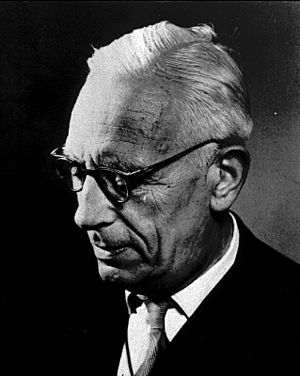Jaap Kunst facts for kids
Jaap Kunst (born August 12, 1891, died December 7, 1960) was a famous Dutch music expert. He was born in Groningen and passed away in Amsterdam.
He is known for creating the word "ethnomusicology". This word describes the study of music from different cultures. Before him, it was called "comparative musicology."
Jaap Kunst spent his life studying folk music. He looked at traditional music from his home country, the Netherlands. He also studied the rich music of Indonesia. He wrote over 70 books and articles about music.
Contents
Jaap Kunst's Early Life
Jaap Kunst was born in 1891 in Groningen, a city in the Netherlands. His parents were both musicians. His father even taught music at a school.
Jaap started playing the violin when he was only 5 years old. He loved the violin and played it his whole life. He became interested in folk music because his family often went on vacation. They visited the island of Terschelling, where he heard traditional songs.
He first decided to become a lawyer. He even published his first music research while studying law. In 1917, he earned a law degree from the University of Groningen. For two years, he worked in banking and law. But he soon found this work boring.
His Work in Indonesia
In 1919, Jaap Kunst went on a trip to the Dutch East Indies. This area is now known as Indonesia. He traveled with two other musicians in a new group. They performed 95 concerts all over Indonesia.
During his travels, Kunst heard a gamelan group for the first time. This was at the Paku Alaman palace in Yogyakarta. He was so amazed by the music that he decided to stay in Java. He wanted to study Indonesian music more deeply. The other musicians in his group went back home.
Jaap Kunst got a job with the local government. He stayed in Java for fifteen years. In 1921, he married Kathy van Wely. She became a very important partner in his music studies.
Jaap Kunst was the first person to record gamelan music. He used special wax cylinders to capture the sounds. He collected many photographs, recordings, and musical instruments from Indonesia. He later gave much of his collection to the Koninklijk Bataviaasch Genootschap van Kunsten en Wetenschappen. This is now the National Museum of Indonesia.
Later Activities and New Ideas
In 1934, Jaap Kunst returned to the Netherlands. Two years later, in 1936, he became the curator of the Colonial Museum in Amsterdam. This museum is now called the Royal Tropical Institute. Later, he also became a teacher at the University of Amsterdam.
In 1950, Kunst used the term "ethno-musicology" for the first time. He used it in his book called Musicologica.
Soon, the word "ethnomusicology" (without the hyphen) became popular. It replaced the older name, "comparative musicology." This change was also helped by the creation of the Society for Ethnomusicology in 1955.
In 1956, Kunst released a very popular album. It was called Living Folksongs and Dance-Tunes from the Netherlands. It featured folk songs from his home country.
Jaap Kunst passed away in 1960.
Jaap Kunst's Ideas About Music
Jaap Kunst believed that to understand music, you must also understand its culture. He thought that studying music was not complete without looking at its cultural background.
At that time, many European experts thought their music was the most advanced. But Kunst disagreed. He strongly believed that music from other continents was just as complex and beautiful as European music. He often argued this point with others.
His Lasting Legacy
Since 1965, the Society for Ethnomusicology has given out a special award. This award is named after Jaap Kunst.
Until 2018, the prize honored the best ethnomusicology article from the past year. Only members of the society could win. From 2019 onwards, the prize is given to newer researchers. These are scholars who have been working in the field for less than 10 years.


